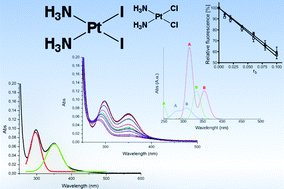cis-Pt I2(NH3)2: a reappraisal†
Abstract
The investigation of cis-PtI2(NH3)2, the diiodido analogue of cisplatin (cisPtI2 hereafter), has been unjustly overlooked so far mainly because of old claims of pharmacological inactivity. Some recent – but still fragmentary – findings prompted us to reconsider more systematically the chemical and biological profile of cisPtI2 in comparison with cisplatin. Its solution behaviour, interactions with DNA and cytotoxic properties versus selected cancer cell lines were thus extensively analysed through a variety of biophysical and computational methods. Notably, we found that cisPtI2 is highly cytotoxic in vitro toward a few solid tumour cell lines and that its DNA platination pattern closely reproduces that of cisplatin; cisPtI2 is also shown to completely overcome resistance to cisplatin in a platinum resistant cancer cell line. The differences in the biological actions of these two Pt complexes are most likely related to slight but meaningful differences in their solution behaviour and reactivity. Overall, a very encouraging and unexpected pharmacological profile emerges for cisPtI2 with relevant implications both in terms of mechanistic knowledge and of prospective clinical application. An ab initio DFT study is also included to support the interpretation of the solution behaviour of cisPtI2 under physiological and slightly acidic pH conditions.


 Please wait while we load your content...
Please wait while we load your content...